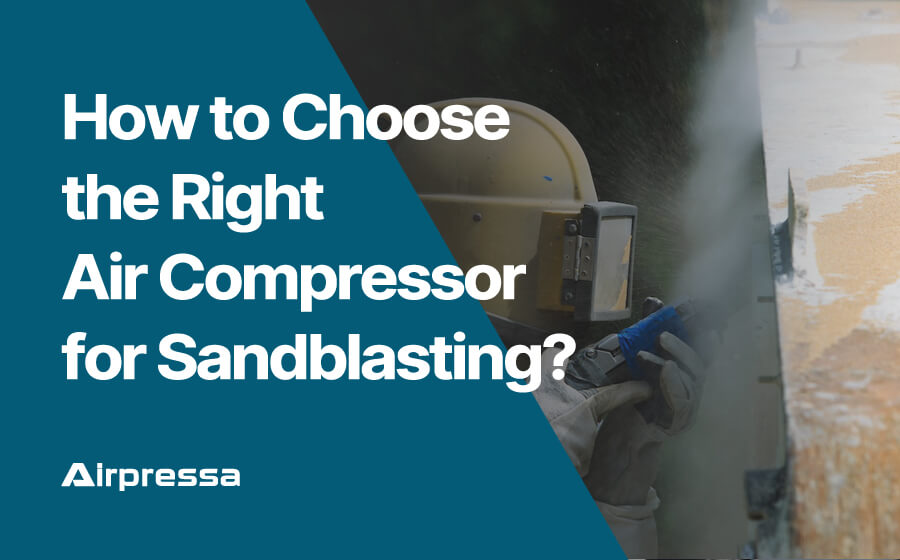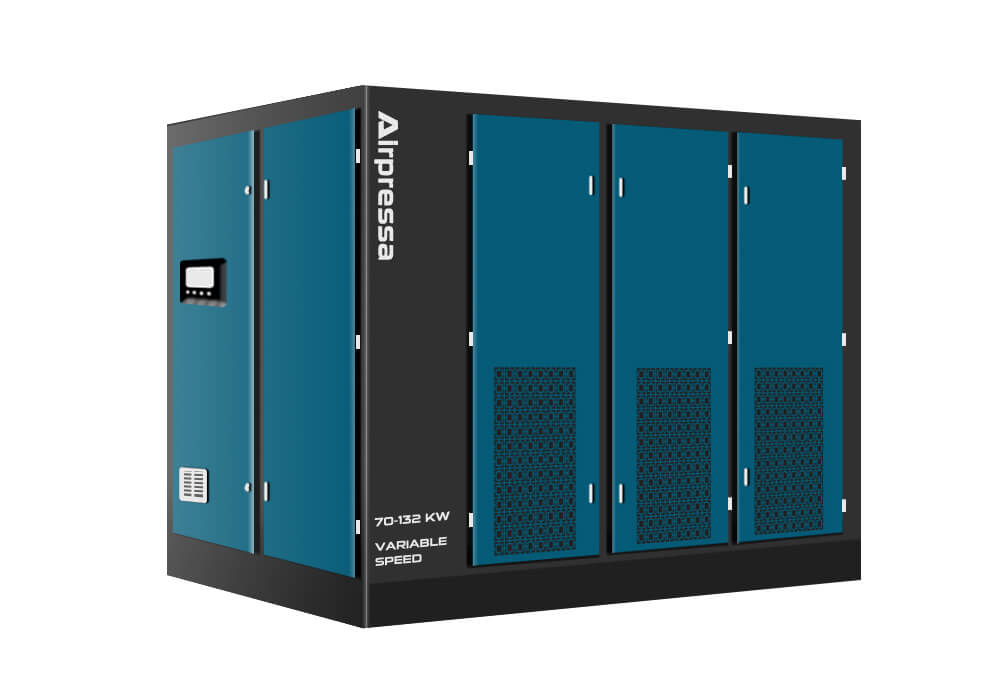
Choosing the right air compressor for sandblasting may bother you for a long time. It requires comprehensive judgment based on multiple situations.
In this article, we’ll explore the role of air compressors in the sandblasting industry and how to select the ideal one for your needs.
You can click on any section that you interest to get there quickly.
- How Air Compressors Are Used in the Sandblasting Industry
- Choosing the Type of Air Compressor for Sandblasting
- Determine the Working Pressure of the Air Compressor
- Oil Lubrication or Oil-free Air Compressor for Sandblasting?
- Energy-Saving Air Compressor for Sandblasting
- Recommended Air Compressor for Sandblasting
- Other Factors to Consider
How Air Compressors Are Used in the Sandblasting Industry
Providing High-Pressure Air
The heart of any sandblasting operation is a reliable air compressor. Air compressors generate and supply the high-pressure air needed to propel abrasive materials.
This high-pressure air is working great for the efficient removal of rust, paint, and contaminants from surfaces.
Ensuring Consistent Airflow
Sandblasting requires a continuous and consistent airflow to achieve uniform results.
A stable air compressors can keep a steady supply of compressed air, preventing interruptions during the sandblasting process.
Controlling Abrasive Flow
The air compressor’s regulator and control systems allow operators to adjust the pressure and flow rate of the compressed air.
This control is essential for different blasting applications, ensuring precision and desired surface finish.
Consideration for Environmental Impact
Some sandblasting projects, especially those involving lead-based paints or hazardous materials, require specialized air compressors equipped with air filtration and recycling systems to mitigate environmental concerns.
Enabling Portability
Unlike stationary air compressors, portable air compressors provide the possibility for mobile sandblasting operations.
Such as on construction sites or for automotive restoration. These compressors provide the flexibility to work in various locations.
Choosing the Type of Air Compressor for Sandblasting
Piston Air Compressor
Pros:
Affordable: Piston compressors are generally more budget-friendly, making them a good choice for small-scale sandblasting projects.
Compact: They come in portable sizes suitable for mobile sandblasting operations.
Simple Maintenance: Maintenance and repairs are often straightforward, and parts are readily available.
Cons:
Limited CFM: Piston compressors may have limitations in providing the required CFM for larger sandblasting tasks.
Intermittent Use: They are better suited for intermittent use rather than continuous operation.
Piston air compressors are a practical choice for hobbyists, occasional sandblasters, and small-scale projects.
Rotary Screw Air Compressor
Pros:
Consistent Airflow: Rotary screw compressors offer a steady and consistent airflow, ensuring uniform sandblasting results.
High CFM: They are capable of providing high CFM rates required for larger and continuous sandblasting applications.
Durability: These compressors are built for continuous operation and can withstand heavy use.
Cons:
Higher Initial Cost: Rotary screw compressors tend to have a higher upfront cost compared to piston compressors.
Maintenance: Maintenance may be more complex, requiring professional service.
Rotary screw air compressors are the preferred choice for industrial sandblasting operations, large projects, and applications demanding high CFM.
Scroll Air Compressor
Pros:
Quiet Operation: Scroll compressors are known for their quiet operation, making them suitable for indoor sandblasting projects.
Energy-Efficient: They are energy-efficient, helping reduce operational costs.
Compact: These compressors have a compact design, saving space in your workspace.
Cons:
Lower CFM: Scroll compressors typically have lower CFM ratings compared to rotary screw compressors.
Limited Size Range: They are best suited for smaller sandblasting tasks due to their size limitations.
Scroll air compressors are ideal for small to medium-sized sandblasting projects, particularly when noise and energy efficiency are important considerations.
Determine the Working Pressure of the Air Compressor
When selecting an air compressor for sandblasting, one of the most critical factors to consider is the working pressure it can deliver.
You should take into account the abrasive material, surface type, desired outcome, and equipment recommendations to determine the appropriate PSI.
Working pressure is typically measured in pounds per square inch (PSI), or bar.
The appropriate PSI for your sandblasting project depends on the type of abrasive material, the surface you’re working on, and the desired results. Here’s how to determine the right working pressure:
- Identify the Abrasive Material
Different abrasive materials require different PSI levels. For example, silica sand may require a higher PSI than glass beads for effective sandblasting.
- Consider the Surface
Delicate surfaces like wood or glass require lower PSI to prevent damage, while heavy metals or concrete may need higher PSI for efficient material removal.
- According to Different Uses
If you need a deep clean or quick paint removal, higher PSI is essential. For more delicate tasks like etching or detailing, lower PSI may suffice.
- Consult the Equipment
Always refer to the manufacturer’s recommendations for the sandblasting equipment you intend to use. They often provide guidelines on the required PSI.
What Are the Negative Effects of Insufficient Air Compressor Pressure?
Using an air compressor with insufficient pressure for your sandblasting project can lead to several issues:
Incomplete Stripping: Inadequate PSI may result in incomplete paint or rust removal, leaving you with an unsatisfactory finish.
Wasted Abrasive Material: Lower pressure can cause abrasive materials to be wasted as they may not effectively remove contaminants or coatings.
Extended Work Time: You’ll spend more time on your project as lower PSI leads to slower material removal.
Uneven Surface: Insufficient pressure can result in an uneven surface finish, affecting the appearance and quality of your work.
Investing in the right air compressor ensures that your sandblasting projects are efficient, effective, and yield high-quality results.
Oil Lubrication or Oil-free Air Compressor for Sandblasting?
The choice between oil-lubricated and oil-free air compressors for sandblasting depends on your specific needs, budget, and maintenance capabilities.
Both types have their merits, and understanding their pros and cons will help you select the right compressor to ensure efficient and effective sandblasting operations.
Oil-Lubricated Air Compressors
Advantages:
Durability: Oil-lubricated compressors are known for their robust construction and long service life. They can handle heavy-duty tasks associated with sandblasting.
Cooling: Oil acts as a natural coolant, helping to dissipate heat generated during compression. This cooling effect can enhance the compressor’s efficiency during extended sandblasting sessions.
Smooth Operation: Oil lubrication reduces friction, resulting in quieter and smoother compressor operation. This can be beneficial in environments where noise is a concern.
Disadvantages:
Oil Contamination: One of the main drawbacks of oil-lubricated compressors is the potential for oil carryover into the compressed air. This oil can contaminate your blasting media or work surface, affecting the quality of your work.
Maintenance: Oil-lubricated compressors require regular oil changes and maintenance to ensure proper functioning and prevent oil contamination issues.
Oil-Free Air Compressors
Advantages:
Clean Air: Oil-free compressors produce clean, oil-free air. This is essential for applications where air quality is critical, such as sandblasting, where oil contamination can ruin the results.
Low Maintenance: Oil-free compressors typically require less maintenance since there’s no need for oil changes replacements.
Disadvantages:
Durability: While oil-free compressors are suitable for many applications, they may have a shorter lifespan than their oil-lubricated counterparts when subjected to heavy sandblasting workloads.
Heat Generation: Oil-free compressors tend to generate more heat during operation due to the absence of lubricating oil. This can lead to reduced efficiency in continuous sandblasting operations.
Making the Right Choice
The choice between oil-lubricated and oil-free air compressors for sandblasting depends on your specific requirements. Here are some guidelines to consider:
If Air Quality Is Critical: If you need absolutely clean air for your sandblasting work, especially in applications like surface preparation for painting or coating, an oil-free compressor is the better choice.
For Heavy-Duty Sandblasting: If you anticipate continuous, heavy-duty sandblasting tasks, an oil-lubricated compressor’s durability and cooling properties might be advantageous, provided you can manage oil carryover issues.
Maintenance Considerations: Consider your maintenance capabilities. Oil-free compressors generally require less maintenance, making them suitable for users looking for a hassle-free solution.
Budget: Oil-free compressors are often more expensive upfront than oil-lubricated ones. Factor in your budget constraints when making a decision.
The Ultimate Guide: What Is The Oil-free Air Compressor?
The oil-free air compressor is one of the most popular types of air compressors. It plays a vital role in many industries and manufacturers.
In this guide, we will delve into the world of oil-free air compressors and explore their benefits, applications, and maintenance requirements.
Energy-Saving Air Compressor for Sandblasting
In the world of sandblasting, where efficiency and performance are paramount.
Variable speed air compressors save energy, reduce maintenance costs, makes them an excellent choice for businesses looking to optimize their sandblasting operations.
Energy Efficiency
Variable speed air compressors, often referred to as Variable Speed Drive (VSD) or Variable Frequency Drive (VFD) compressors, are designed to match their output to the exact air demand.
This means they operate at varying speeds rather than running at a constant speed like traditional compressors. As a result, they are exceptionally energy-efficient.
In sandblasting, where continuous operation is common, an energy-saving compressor can lead to significant cost reductions.
Flexibility
VSD compressors can adapt to changing demands in real-time. Sandblasting projects can vary significantly in terms of scope and complexity. A compressor that can flexibly adjust to these changes is a valuable asset.
Space-Saving
Variable speed compressors are often more compact than traditional compressors with the same output capacity. This can be advantageous when space is limited, a common constraint in sandblasting setups.
Environmental Benefits
The energy efficiency of VSD compressors translates into reduced carbon emissions. For businesses focused on sustainability, this can be an essential factor in their choice of equipment.
What is the VSD Compressor and How to Choose Correctly
VSD compressor is a cutting-edge technology that has gained significant traction in recent years.
These advanced compressors have revolutionized the way compressed air is generated, offering unmatched energy-saving capabilities, flexibility, and control. But what exactly is a VSD compressor, and how do you choose the right one for your business?
Recommended Air Compressor for Sandblasting
To sum up, in order to meet the air volume demand, stability, efficiency, energy cost, continuous working ability, etc. during sandblasting, the high-pressure variable speed rotary screw air compressor has almost become the first choice.

Variable Speed Air Compressors 75-132 kw 100-175 hp
Gas Type: Air
Oil Lubricated & Oil Free
Driven method: PM Variable Speed
Series: Rotary Screw Air Compressor
Power: 75/90/110/132 kw
Pressure: 8/9/10/12/13/16 bar
Other Factors to Consider
Portable vs. Stationary
Decide whether you need a portable or stationary compressor based on your operational requirements.
Portable compressors offer mobility but may have slightly lower capacity than their stationary counterparts.
Diesel compressors
Ensure you have the appropriate power source for your compressor. While electric compressors are common, diesel-powered compressors are preferred for remote or outdoor sandblasting projects.
Click to check our diesel compressor series.
Check Air Receiver Tank Size
If your sandblasting work involves intermittent blasting, consider a compressor with a larger tank to store compressed air. This can reduce the load on the compressor motor and provide a more consistent airflow.